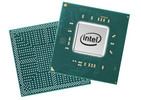Intel Celeron J4005 vs Intel Pentium Silver J5005
Intel Celeron J4005
► remove from comparisonThe Intel Celeron J4005 is a dual-core desktop SoC primarily for mini PCs and mini ITX mainboards. It runs at 2 - 2.7 GHz (Single Core Burst) and is based on the Gemini Lake platform. Similar to the Apollo Lake predecessor, the chip is manufactured in a 14 nm process with FinFETs but offers slightly improved processor cores, double the amount of L2 cache, a smaller package, a new generation of monitor outputs (Gen 10) and a partly integrated WiFi chip. Besides four CPU cores, the chip also includes a DirectX 12 capable GPU as well as a DDR4/LPDDR4 memory controller (dual-channel, up to 2400 MHz). The SoC is not replaceable as it is permanently soldered to the mainboard.
Architecture
The processor architecture was slightly reworked and is now called Goldmont Plus. It features an increased level 2 cache (to 4 MB). That means the per-clock-performance should be a bit better, but not anywhere near the Core CPUs like Kaby Lake Y.
Performance
The average J4005 in our database is in the same league as the Celeron N3450 and the Celeron 3865U, as far as multi-thread benchmark scores are concerned. This is an abysmally poor result, as of early 2023.
Power consumption
This Celeron series chip has a default TDP, also known as the long-term power limit, of 10 W. That's not much at all and thus good enough for passively cooled tablets, laptops and mini-PCs.
The J4005 is built with one of Intel's old 14 nm processes for poor, as of early 2023, energy efficiency.
Intel Pentium Silver J5005
► remove from comparison
The Intel Pentium Silver J5005 is a quad-core SoC that was introduced at the end of 2017 and is mainly used in inexpensive mini PCs. It clocks from 1.5 to 2.8 GHz (single-core burst) and belongs to the Gemini Lake platform. In addition to the four CPU cores, the chip also integrates a DirectX 12-capable graphics unit and a DDR4/LPDDR4 memory controller (dual channel, 2,400 MHz). The SoC cannot be replaced as it is soldered directly to the mainboard (BGA package).
Architecture
The processor architecture of the Gemini Lake SoCs has been slightly enhanced compared to its predecessor. Intel now calls them Goldmont Plus cores and doubles the level 2 cache from 2 to 4 MB. Nevertheless, the per-MHz performance should still remain well behind the current Kaby Lake processors.
Performance
The CPU performance of the J5005 with 4 CPU cores is only in the entry-level class and is only sufficient for undemanding tasks. Even when surfing the web, you notice a clear difference to faster processors.
Power consumption
Like its predecessor, the entire SoC is specified by Intel with a TDP of 10 watts.
| Model | Intel Celeron J4005 | Intel Pentium Silver J5005 | ||||||||||||||||||||||||||||||||||||||||||||||||||||||||
| Codename | Gemini Lake | Gemini Lake | ||||||||||||||||||||||||||||||||||||||||||||||||||||||||
| Series | Intel Gemini Lake | Intel Gemini Lake | ||||||||||||||||||||||||||||||||||||||||||||||||||||||||
| Series: Gemini Lake Gemini Lake |
|
| ||||||||||||||||||||||||||||||||||||||||||||||||||||||||
| Clock | 2000 - 2700 MHz | 1500 - 2800 MHz | ||||||||||||||||||||||||||||||||||||||||||||||||||||||||
| L1 Cache | 112 KB | |||||||||||||||||||||||||||||||||||||||||||||||||||||||||
| L2 Cache | 4 MB | 4 MB | ||||||||||||||||||||||||||||||||||||||||||||||||||||||||
| Cores / Threads | 2 / 2 | 4 / 4 4 x 2.8 GHz Intel Goldmont Plus | ||||||||||||||||||||||||||||||||||||||||||||||||||||||||
| TDP | 10 Watt | 10 Watt | ||||||||||||||||||||||||||||||||||||||||||||||||||||||||
| Technology | 14 nm | 14 nm | ||||||||||||||||||||||||||||||||||||||||||||||||||||||||
| max. Temp. | 105 °C | 105 °C | ||||||||||||||||||||||||||||||||||||||||||||||||||||||||
| Socket | BGA1090 | BGA1090 | ||||||||||||||||||||||||||||||||||||||||||||||||||||||||
| Features | DDR4-2400/LPDDR4-2400 RAM, PCIe 2, MMX, SSE, SSE2, SSE3, SSSE3, SSE4.1, SSE4.2, VMX, SMEP, SMAP, MPX, EIST, TM1, TM2, Turbo, AES-NI, RDRAND, RDSEED, SHA, SGX | DDR4-2400/LPDDR4-2400 RAM, PCIe 2, MMX, SSE, SSE2, SSE3, SSSE3, SSE4.1, SSE4.2, VMX, SMEP, SMAP, MPX, EIST, TM1, TM2, Turbo, AES-NI, RDRAND, RDSEED, SHA, SGX | ||||||||||||||||||||||||||||||||||||||||||||||||||||||||
| iGPU | Intel UHD Graphics 600 (250 - 700 MHz) | Intel UHD Graphics 605 (250 - 800 MHz) | ||||||||||||||||||||||||||||||||||||||||||||||||||||||||
| Architecture | x86 | x86 | ||||||||||||||||||||||||||||||||||||||||||||||||||||||||
| $107 U.S. | ||||||||||||||||||||||||||||||||||||||||||||||||||||||||||
| Announced | ||||||||||||||||||||||||||||||||||||||||||||||||||||||||||
| Manufacturer | ark.intel.com | ark.intel.com |
Benchmarks
Average Benchmarks Intel Celeron J4005 → 100% n=16
Average Benchmarks Intel Pentium Silver J5005 → 166% n=16
* Smaller numbers mean a higher performance
1 This benchmark is not used for the average calculation












